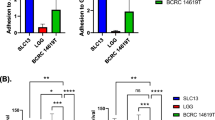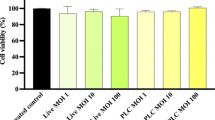Abstract
Helicobacter pylori, a microaerophilic fastidious bacterium, has been cultured on various plating and broth media since its discovery. Although the agar media can be sufficient for the identification, typing, and antibiotic resistance studies, no secretory antigen of H. pylori can be evaluated in such media. Thus, satisfactory growth of H. pylori in liquid culture which is needed for analysis of secretory proteins without the presence of interfering agents is in demand. We assessed the impact of β-cyclodextrin, Fetal Bovine Serum (FBS), and charcoal as supplements for H. pylori growth. Furthermore, we aimed to identify the most favorable supplement that supports the secretion of the dominant secretory protein, vacuolating cytotoxin (VacA). Five clinical strains were cultured on broth media and the growth, viability, morphology, and protein content of each strain were determined. Our results revealed that β-cyclodextrin supports the growth rate, viability, and cell lysate protein content to the extent similar to FBS. Application of β-cyclodextrin is found to postpone spiral to coccoid conversion up to 72 h of incubation. Although FBS supports a higher VacA protein content, presence of interfering macromolecules in FBS questions its utility particularly for purposes of studying extra cellular proteins such as VacA. This study recommends further application of β-cyclodextrin as a culture supplement with the potential capacity in neutralizing toxic compounds and flourishing the secretion of H. pylori proteins without addition of interfering proteins.





Similar content being viewed by others
References
Peek RMJ, Blaser MJ (2002) Helicobacter pylori and gastrointestinal tract adenocarcinomas. Nat Rev Cancer 2:28–37
Shirin H, Leja M, Niv Y (2008) Helicobacter pylori and non-malignant diseases. Helicobacter 13:23–27
Piccolomini R, Di Bonaventura G, Festi D, Catamo G, Laterza F, Neri M (1997) Optimal combination of media for primary isolation of Helicobacter pylori from gastric biopsy specimens. J Clin Microbiol 35:1541–1544
Schraw W, McClain MS, Cover TL (1999) Kinetics and mechanisms of extracellular protein release by Helicobacter pylori. Infect Immun 67:5247–5252
Sewald X, Fischer W, Haas R (2008) Sticky socks: Helicobacter pylori VacA takes shape. Trends Microbiol 16:89–92
Sainsus N, Cattori V, Lepadatu C, Hofmann-Lehmann R (2008) Liquid culture medium for the rapid cultivation of Helicobacter pylori from biopsy specimens. Eur J Clin Microbiol Infect Dis 27:1209–1217
Stevenson TH, Castillo A, Lucia LM, Acuff GR (2000) Growth of Helicobacter pylori in various liquid and plating media. Lett Appl Microbiol 30:192–196
Kitsos CM, Stadtlander CT (1998) Helicobacter pylori in liquid culture: evaluation of growth rates and ultrastructure. Curr Microbiol 37:88–93
Jiang X, Doyle MP (2000) Growth supplements for Helicobacter pylori. J Clin Microbiol 38:1984–1987
Labigne A, Cussac V, Courcoux P (1991) Shuttle cloning and nucleotide sequences of Helicobacter pylori genes responsible for urease activity. J Bacteriol 173:1920–1931
Marshall BJ, Warren JR (1984) Unidentified curved bacilli in the stomach of patients with gastritis and peptic ulceration. Lancet 16:1311–1315
Walsh EJ, Moran AP (1997) Influence of medium composition on the growth and antigen expression of Helicobacter pylori. J Appl Microbiol 83:67–75
Zheng X, Baker H, Hancock WS, Fawaz F, McCaman M, Pungor EJ (2006) Proteomic analysis for the assessment of different lots of fetal bovine serum as a raw material for cell culture. Part IV. Application of proteomics to the manufacture of biological drugs. Biotechnol Prog 22:1294–1300
Gstraunthaler G (2003) Alternatives to the use of fetal bovine serum: serum-free cell culture. ALTEX 20:275–281
Shahamat M, Mai UE, Paszko-Kolva C, Yamamoto H, Colwell RR (1991) Evaluation of liquid media for growth of Helicobacter pylori. J Clin Microbiol 29:2835–2837
Erickson GA, Bolin SR, Landgraf JG (1991) Viral contamination of fetal bovine serum used for tissue culture: risks and concerns. Dev Biol Stand 75:173–175
Plavsic MZ, Prodafikas G (2001) Evaluation of a new sandwich enzyme-linked immunosorbent assay for detection of bovine viral diarrhea virus in unprocessed fetal bovine serum. J Vet Diagn Invest 13:261–262
Woods RD, Kunkle RA, Ridpath JE, Bolin SR (1999) Bovine viral diarrhea virus isolated from fetal calf serum enhances pathogenicity of attenuated transmissible gastroenteritis virus in neonatal pigs. J Vet Diagn Invest 11:400–407
Zabal O, Kobrak AL, Lager IA, Schudel AA, Weber EL (2000) Contamination of bovine fetal serum with bovine viral diarrhea virus. Rev Argent Microbiol 32:27–32
Kimura T, Wada A, Nakayama M, Ogushi K, Nishi Y, De Guzman BB, Moss J, Hirayama T (2003) High molecular weight factor in FCS inhibits Helicobacter pylori VacA-binding to its receptor, RPTPbeta, on AZ-521. Microbiol Immunol 47:105–107
Olivieri R, Bugnoli M, Armellini D, Bianciardi S, Rappuoli R, Bayeli PF, Abate L, Esposito E, de Gregorio L, Aziz J et al (1993) Growth of Helicobacter pylori in media containing cyclodextrins. J Clin Microbiol 31:160–162
McKenzie RC, Harley CB, Matic S, Sauder DN (1990) Fetal bovine serum contains an inhibitor of interleukin-1. J Immunol Methods 133:99–105
Mortell KH, Marmorstein AD, Cramer EB (1993) Fetal bovine serum and other sera used in tissue culture increase epithelial permeability. In Vitro Cell Dev Biol 29A:235–238
Li Z, Wang M, Wang F, Gu Z, Du G, Wu J, Chen J (2007) gamma-cyclodextrin: a review on enzymatic production and applications. Appl Microbiol Biotechnol 77(2):245–255
Taneera J, Moran AP, Hynes SO, Nilsson HO, Al-Soud W, Wadstrom T (2002) Influence of activated charcoal, porcine gastric mucin and beta-cyclodextrin on the morphology and growth of intestinal and gastric Helicobacter spp. Microbiology 148:667–684
Davis ME, Brewster ME (2004) Cyclodextrin-based pharmaceutics: past, present and future. Nat Rev Drug Discov 3:1023–1035
Bond GR (2002) The role of activated charcoal and gastric emptying in gastrointestinal decontamination: a state-of-the-art. Ann Emerg Med 39:273–286
Lapus RM (2007) Activated charcoal for pediatric poisonings: the universal antidote? Curr Opin Pediatr 19:216–222
Alvarez B, Guijarro JA (2007) Recovery of Flavobacterium psychrophilum viable cells using a charcoal-based solid medium. Lett Appl Microbiol 44:569–572
Daneshvar MI, Hollis DG, Weyant RS, Jordan JG, MacGregor JP, Morey RE, Whitney AM, Brenner DJ, Steigerwalt AG, Helsel LO, Raney PM, Patel JB, Levett PN, Brown JM (2004) Identification of some charcoal-black-pigmented CDC fermentative coryneform group 4 isolates as Rothia dentocariosa and some as Corynebacterium aurimucosum. J Clin Microbiol 42:4189–4198
Dougherty MJ, Spach DH, Larson AM, Hooton TM, Coyle MB (1996) Evaluation of an extended blood culture protocol to isolate fastidious organisms from patients with AIDS. J Clin Microbiol 34:2444–2447
Ermolaeva S, Belyi Y, Tartakovskii I (1999) Characteristics of induction of virulence factor expression by activated charcoal in Listeria monocytogenes. FEMS Microbiol Lett 174:137–141
Marchini A, d’Apolito M, Massari P, Atzeni M, Copass M, Olivieri R (1995) Cyclodextrins for growth of Helicobacter pylori and production of vacuolating cytotoxin. Arch Microbiol 164:290–293
Author information
Authors and Affiliations
Corresponding author
Rights and permissions
About this article
Cite this article
Douraghi, M., Saberi Kashani, S., Zeraati, H. et al. Comparative Evaluation of Three Supplements for Helicobacter pylori Growth in Liquid Culture. Curr Microbiol 60, 254–262 (2010). https://doi.org/10.1007/s00284-009-9534-4
Received:
Accepted:
Published:
Issue Date:
DOI: https://doi.org/10.1007/s00284-009-9534-4




